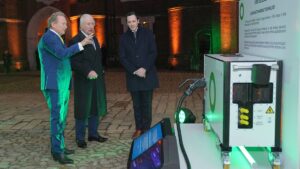IPO Watch: This IPO candidate says miners can’t just mine – they have to play politics

Mining's not just about mining anymore, says Bronwyn Barnes. Pic: Getty Images
- Robert Friedland-backed Ivanhoe Atlantic could be ready to run an IPO by December
- Led by Australian president and CEO Bronwyn Barnes, the company is aiming to develop a large high grade African iron ore deposit once owned by BHP
- Barnes says understanding politics is now the main game for mining companies, as Ivanhoe looks to supply critical US market
Ivanhoe Atlantic president and CEO Bronwyn Barnes says the Robert Friedland-backed company “would like to be ready” to launch its IPO by December in what is likely to be the largest ASX mining float since 2021.
And it’s working closely with Washington in a bid to bring an African iron ore mine, virtually abandoned by BHP (ASX:BHP), into production as soon as 2027.
A consortium led by billionaire US-Canadian nickel and copper entrepreneur Friedland secured what was previously known as the Nimba deposit in Guinea off BHP and Newmont in 2019.
It has since been renamed Kon Kweni and progressed privately, with plans to extract the project’s high grade iron ore and transport it across the border to existing rail infrastructure in Liberia currently operated by steel giant ArcelorMittal.
With a 750Mtpa DSO resource including a high grade portion in excess of 200Mt at 67.5% Fe, the idea is to provide a supply of high grade iron ore that can be readily processed in Middle East DRI plants into low emissions steel that can feed a US supply chain which excludes the world’s largest steel producer China.
The planned float comes in the context of a trade cold war between Trump’s America and Xi Jinping’s China, which Barnes told an audience at the WA Mining Club will likely last long beyond the strongman leaders’ terms in power.
“This is another whole level of critical thinking that I don’t think historically as mining companies that we’ve had to do,” she said on Thursday.
“We don’t play mining, we play geopolitics. So what does that mean for us?
“I’m really interested in assets beyond Kon Kweni – assets that sit on the critical minerals supply list for the US, in jurisdictions that are allies to the US.”
That extends in part to the iron ore at Kon Kweni as well. Barnes says the importance of keeping Chinese capital off its register has been a big feature of discussions with Department officials in Washington.
The US is a fading steel power, with around 70% of its production coming from the reduction of scrap in electric arc furnaces. Scrap doesn’t produce steel with the qualities required for applications like defence and shipbuilding, Barnes says.
Why Australia?
Friedland is no stranger to the Australian market, with the nickel, cobalt and scandium play he chairs – Sunrise Energy Metals (ASX:SRL) – among his myriad investments.
At the same time, his biggest success stories have come in North America – Ivanhoe Mines, which developed the Kamoa-Kakula copper mine in the DRC with China’s Zijin, is listed in Toronto, as was Turquoise Hill, which eventually sold its stake in the Oyu Tolgoi copper mine in Mongolia to Rio Tinto, and Diamond Fields Resources, which found the world class Voisey’s Bay nickel mine in Canada.
But Barnes thinks the Australian market is the ideal avenue for a new iron ore developer.
“First of all, Australia has the highest knowledge of iron ore,” she told media after the fireside chat at Optus Stadium.
“This is the only country in the world where you can come and ask anyone on the main street, what’s the iron ore price today and they’ll be able to tell you.
“And also the familiarity with African jurisdictions. We’ve really seen the hollowing out of the UK markets.
“London’s not open.
“They’re not doing any big IPOs. There are some getting away in North America, but this makes much more sense to be in Australia.”
The key step to trigger that will be the ratification of a rail access agreement with the Government of Liberia, expected in Q4, after which will come a development expected to take 12-18 months, depending on whether the company can avoid the onset of the wet season.
“I’d like to launch it by December but don’t hold me to it,” Barnes told the room.
Iron ore markets
Another iron ore development in Guinea, the Rio Tinto and China-backed Simandou, has struck fear into the market in recent years, with progress after 30 years of stalled development threatening the entry of as much as 120Mtpa of new material into the seaborne iron ore market once fully ramped up.
Prices for the bulk commodity’ benchmark 62% Fe product – 60% of which is shipped out of WA’s Pilbara region – have sat around US$100/t for some time.
Could the entry of new suppliers in Guinea like Simandou and Kon Kweni hurt their own economics?
Barnes doesn’t view African production as a ‘Pilbara killer’, saying the Pilbara still has the lowest production costs in the world.
“Our production, we’re only going to start at 2-5Mtpa, it will take us a couple years to ramp up to 30Mtpa. That’s really nothing in terms of the world stage,” she said.
“The biggest constraint that the African countries have still is infrastructure and getting their product to market. And infrastructure takes a long time to develop in Africa.”
But Ivanhoe continues to be optimistic on the price outlook for iron ore in general.
“We’ve maintained a long term pricing in all our modelling of US$100 a tonne. And that doesn’t account for any of the upgrades that you would or the premium you’d expect to see on pricing for our high grade,” Barnes said.
“That 100 bucks a tonne is based on about 62% iron, we’re doing 67-67.5% iron.
“We’re pretty comfortable that the long term price will sit around 100 bucks a tonne.”
Related Topics
UNLOCK INSIGHTS
Discover the untold stories of emerging ASX stocks.
Daily news and expert analysis, it's free to subscribe.
By proceeding, you confirm you understand that we handle personal information in accordance with our Privacy Policy.








